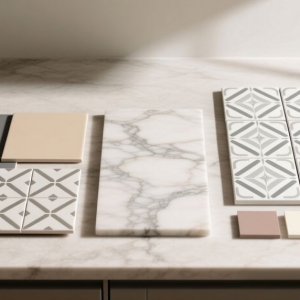Italian tiles have long been a symbol of craftsmanship and innovation, shaping the world of interior design. Known for their durability and aesthetic versatility, Italian ceramic tiles continue to lead global trends. In 2025, the focus is on natural beauty, sustainability, and creative applications. Here’s a look at the trends defining Italian tiles this year.
Nature-Inspired Surfaces
The natural world is a major influence in 2025. Italian ceramic tiles are designed to reflect the textures and tones of stone, clay, and timber. These tiles move away from glossy finishes, embracing subtle irregularities and organic patterns that feel authentic.
Tiles inspired by travertine, with its soft, porous look, are in high demand. Similarly, slate-like Italian tiles with rugged, matte surfaces bring a sense of calm to interiors. These designs allow homeowners to create spaces that feel grounded, blending the beauty of nature with the practicality of ceramic.
Warm, Timeless Colors
Cool, sterile tones are being replaced by warm, earthy hues. Italian tiles in 2025 feature shades like beige, taupe, and soft terracotta, creating inviting and versatile spaces. These colors offer a modern take on traditional terracotta, with lighter tones and subtle undertones of pink or cream.
Italian ceramic tiles in these palettes are highly adaptable, complementing materials like wood, metal, or fabric. They work equally well in sleek, contemporary spaces or cozy, traditional homes, making them a go-to choice for designers.
Bold Marble Inspirations
Marble-effect Italian tiles are bolder than ever in 2025. Designers are embracing tiles with dramatic veining in vibrant colors—think creamy white with emerald streaks or dark grey with copper veins. These striking patterns make surfaces stand out, turning floors and walls into art.
Large-format Italian ceramic tiles enhance this trend, offering seamless installations that rival the grandeur of natural marble. Their durability and low maintenance make them ideal for creating luxurious, high-impact spaces without the upkeep of real stone.
Connecting Indoor and Outdoor Spaces
As homes embrace open, fluid layouts, Italian tiles are bridging the gap between indoor and outdoor areas. In 2025, manufacturers offer tiles with weather-resistant and slip-proof properties, suitable for terraces, patios, or interior floors. The key is continuity—designs that flow seamlessly from a living room to a garden.
This approach creates cohesive, expansive spaces that feel connected to their surroundings. Italian ceramic tiles make it easy to design environments that are both practical and visually harmonious.
The Handcrafted Aesthetic
The artisanal look is a defining trend for 2025. Italian tiles feature irregular edges, hand-painted patterns, and uneven glazes that evoke the charm of small-scale craftsmanship. Some designs mimic hand-pressed clay, while others resemble delicate, hand-drawn motifs.
This trend reflects a cultural shift toward individuality. Italian ceramic tiles, with their roots in Italy’s regional workshops, offer surfaces that feel personal and authentic, even in large-scale projects.
Sustainability as a Priority
Sustainability is at the forefront of the tile industry. Italian manufacturers are adopting eco-friendly practices, using recycled materials and optimizing production to minimize waste. Italian ceramic tiles are also built to last, reducing the need for frequent replacements.
For environmentally conscious buyers, Italian tiles offer a balance of style and responsibility. Their durability and sustainable production make them a smart choice for modern, eco-friendly design.
Creative Uses for Tiles
Italian tiles are no longer limited to floors and walls. In 2025, they’re appearing on kitchen islands, staircases, and even furniture. Thin, lightweight Italian ceramic tiles make these applications possible, combining the strength of ceramic with the flexibility to clad unique surfaces.
Picture a fireplace wrapped in marble-effect tiles or a dining table covered in stone-look ceramic. These uses blend aesthetics with functionality, as ceramic resists stains and wear better than many natural materials.
Texture as a Statement
Texture is a key focus in 2025. Italian tiles are embracing matte finishes, embossed designs, and three-dimensional patterns that add depth to surfaces. Tiles with subtle ridges or woven textures create dynamic visuals that shift with the light.
These tactile surfaces redefine luxury, making Italian ceramic tiles a sensory experience. They elevate spaces by focusing on how surfaces feel as much as how they look.
Tiles with Cultural Depth
Italian tiles in 2025 are inspired by cultural and historical influences. Collections draw from ancient Roman mosaics, Mediterranean patterns, or global designs like Moroccan geometry. These tiles add a narrative layer to spaces, connecting them to heritage and tradition.
For designers, this trend transforms surfaces into storytelling elements. A floor inspired by Venetian artistry or a wall echoing Sicilian motifs becomes a focal point with meaning.
Why Italian Tiles Endure
Italian ceramic tiles remain unmatched because they blend craftsmanship with innovation. The 2025 trends—natural textures, warm palettes, bold marbles, and sustainable practices—showcase their versatility and timeless appeal. Whether used in a small bathroom or an expansive outdoor space, Italian tiles deliver style and functionality.
They’re more than surfaces; they’re a foundation for design. In 2025, Italian tiles continue to inspire, proving why they remain a global leader.











